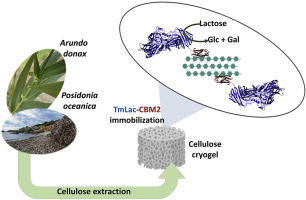当前位置:
X-MOL 学术
›
Food Hydrocoll.
›
论文详情
Our official English website, www.x-mol.net, welcomes your
feedback! (Note: you will need to create a separate account there.)
Revalorization of cellulosic wastes from Posidonia oceanica and Arundo donax as catalytic materials based on affinity immobilization of an engineered β-galactosidase
Food Hydrocolloids ( IF 11.0 ) Pub Date : 2020-06-01 , DOI: 10.1016/j.foodhyd.2019.105633 María José Fabra , Isabel Seba-Piera , David Talens-Perales , Amparo López-Rubio , Julio Polaina , Julia Marín-Navarro
Food Hydrocolloids ( IF 11.0 ) Pub Date : 2020-06-01 , DOI: 10.1016/j.foodhyd.2019.105633 María José Fabra , Isabel Seba-Piera , David Talens-Perales , Amparo López-Rubio , Julio Polaina , Julia Marín-Navarro

|
Abstract Catalytic materials obtained by enzyme immobilization have multiple potential applications in the food industry. The choice of the immobilization method and support may be critical to define the properties of the immobilized enzyme compared to the soluble form. Although the use of immobilized enzymes shows multiple advantages, their catalytic efficiency is compromised in many instances. Molecular engineering techniques have been used to generate hybrid proteins where the enzyme of interest is fused to a module with affinity to a specific biopolymer. Binding of the hybrid TmLac-CBM2 protein, in which the β-galactosidase from Thermotoga maritima is fused to a carbohydrate-binding module from Pyrococcus furiosus, to cellulosic material from aquatic biomass wastes (such as Posidonia oceanica and Arundo donax) has been assayed. Both species generate environmental wastes that could be revalorized if converted into bioactive materials. Cellulose cryogels, but not films, from P. oceanica were able to bind the TmLac-CBM2 hybrid, with a higher immobilization yield (90%) than that from A. donax cellulose cryogels (60%). However, fractions containing also hemicellulose were less effective as immobilization supports in both cases, with yields of 47% and 30%, respectively. Cellulose cryogels loaded with β-galactosidase were able to hydrolyse lactose with the same efficiency as the free form of the enzyme. In contrast, enzyme-loaded cellulose films were inactive. This study represents a proof of concept for the valorisation of cellulosic wastes as bioactive materials. Furthermore, it provides information about the interaction specificity between the binding module and the cellulosic support, useful for other enzymes.
中文翻译:

基于工程化 β-半乳糖苷酶的亲和固定化,将来自 Posidonia Oceanica 和 Arundo donax 的纤维素废物作为催化材料进行再利用
摘要 酶固定化获得的催化材料在食品工业中具有多种潜在应用。与可溶形式相比,固定化方法和支持物的选择对于确定固定化酶的特性可能至关重要。尽管使用固定化酶显示出多种优势,但在许多情况下它们的催化效率会受到影响。分子工程技术已被用于产生杂化蛋白质,其中感兴趣的酶与对特定生物聚合物具有亲和力的模块融合。杂种 TmLac-CBM2 蛋白(其中来自海栖热袍菌的 β-半乳糖苷酶与来自激烈火球菌的碳水化合物结合模块融合)与来自水生生物质废物(如 Posidonia oceanica 和芦竹)的纤维素材料的结合已被测定。这两种物种都会产生环境废物,如果转化为生物活性材料,这些废物就可以重新估价。来自 P. Oceanica 的纤维素冷冻凝胶,但不是薄膜,能够结合 TmLac-CBM2 杂交体,其固定产率 (90%) 比来自 A. donax 纤维素冷冻凝胶的 (60%) 更高。然而,在这两种情况下,还含有半纤维素的馏分作为固定支持物的效果较差,产率分别为 47% 和 30%。加载有 β-半乳糖苷酶的纤维素冷冻凝胶能够以与游离形式的酶相同的效率水解乳糖。相比之下,加载酶的纤维素薄膜是无活性的。这项研究代表了纤维素废物作为生物活性材料的价值化的概念证明。此外,
更新日期:2020-06-01
中文翻译:

基于工程化 β-半乳糖苷酶的亲和固定化,将来自 Posidonia Oceanica 和 Arundo donax 的纤维素废物作为催化材料进行再利用
摘要 酶固定化获得的催化材料在食品工业中具有多种潜在应用。与可溶形式相比,固定化方法和支持物的选择对于确定固定化酶的特性可能至关重要。尽管使用固定化酶显示出多种优势,但在许多情况下它们的催化效率会受到影响。分子工程技术已被用于产生杂化蛋白质,其中感兴趣的酶与对特定生物聚合物具有亲和力的模块融合。杂种 TmLac-CBM2 蛋白(其中来自海栖热袍菌的 β-半乳糖苷酶与来自激烈火球菌的碳水化合物结合模块融合)与来自水生生物质废物(如 Posidonia oceanica 和芦竹)的纤维素材料的结合已被测定。这两种物种都会产生环境废物,如果转化为生物活性材料,这些废物就可以重新估价。来自 P. Oceanica 的纤维素冷冻凝胶,但不是薄膜,能够结合 TmLac-CBM2 杂交体,其固定产率 (90%) 比来自 A. donax 纤维素冷冻凝胶的 (60%) 更高。然而,在这两种情况下,还含有半纤维素的馏分作为固定支持物的效果较差,产率分别为 47% 和 30%。加载有 β-半乳糖苷酶的纤维素冷冻凝胶能够以与游离形式的酶相同的效率水解乳糖。相比之下,加载酶的纤维素薄膜是无活性的。这项研究代表了纤维素废物作为生物活性材料的价值化的概念证明。此外,











































 京公网安备 11010802027423号
京公网安备 11010802027423号